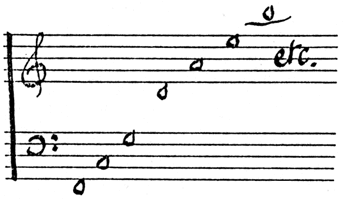
 |
To play mediæval music in tune on a fixed-pitch instrument poses few problems. As we said, the harmony uses intervals which are four, five and eight notes apart - notes 1 to 4 in the natural series at the important points: e.g.
 |
ex.2: 5th harmonies on main points (Codex de las Huelgas, l3thC.)
* there will be sound examples here soon *
If you start to tune with F, and set the fifth note above it, c, in tune: and set the fourth note above that, f, also in tune: then the upper f, the eighth note (nota octava, the octave) from the starting note, will also be in tune. You can carry on tuning fifth notes and their octaves until you have all the notes you need:
 |
ex.3: fifths
or, more conveniently:
 |
ex.4: fifths and octaves
and all your fifths, fourths and octaves will sound lovely and pure and feel very satisfying in your body: indeed ever since the Middle Ages these intervals have been considered 'perfect'.
Mediaeval musicians attributed this system to Pythagoras (c.500 B.C.) and it is still called 'Pythagorean tuning'.
If you now try playing a piece which uses the interval of three notes, a third, at the important points, using this tuning, e.g.:
 |
ex.4: fifths and octaves (Orkneys, 12thC.)
you will experience very nasty beats. You can then understand that, in Pythagorean tuning, the thirds simpy are dissonant: it's not a question of some austere mediæval way of looking at worldly things, as most music history books suggest, it's an observable fact for anyone who listens.
![]()
|